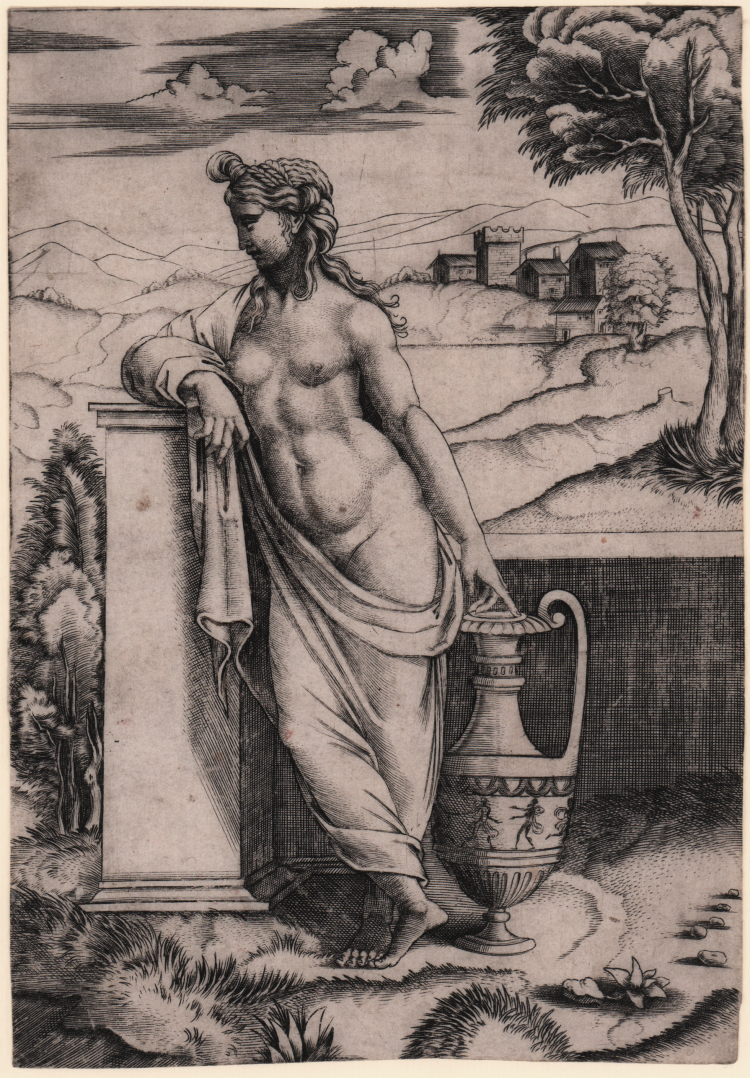



| Reference: | 4309 |
| Author | Agostino de Musi detto VENEZIANO |
| Year: | 1518 ca. |
| Measures: | 140 x 210 mm |


| Reference: | 4309 |
| Author | Agostino de Musi detto VENEZIANO |
| Year: | 1518 ca. |
| Measures: | 140 x 210 mm |
A standing female nude, touching a tall vase with her left hand, in front of a low wall with a landscape behind.
Engraving, 1518 circa, without signature.
Magnificent work rich in shades, printed on thin contemporary laid paper with “King’s head with crown in a circle”, trimmed to marginal line, light oxidations, otherwside in very good condition.
This sheet belongs to a group of engravings depicting young women with vases. The bodies, which are not very much cloche, are extremely beautiful and elegant.
According to Bartsch, these subjects derive from Raffaello, while both Passavant and Oberhuber said they are after Giulio Romano or Luca Penni.
The attribution to Agostino is by Bartsch. A related drawing in reverse is in the Louvre, inv.3585 recto.
Collection's mark of Luciana Simonetti (Lugt 3616) on verso.
|
Bartsch, XIV, p.353, 474; Passavant, p. 594, 90; Oberuhuber, Roma e lo stile classico di Raffaello, p. 196, 130. Dimensioni 140x210.
|
Agostino de Musi detto VENEZIANO (Venezia 1490 ca. - Roma 1536/38)
|
Heir of the great tradition of the Raimondi’s, Agostino Musi, from the family de Masyus or dè Musis, also known as the Veneziano, derives his nick name from the city where he studied the “giorgionesco” style of Giulio Campagnola, di Jacopo dè Barbari and Dürer.
For a while, Agostino lived in Florence translating works from Andrea del Sarto. After that, he moved to Rome where he started working in the workshop of Bavero di Carrocci (aka Baviera) from 1516 till the Sack (Sacco) of the City.
After the Sack, he very likely went back to Florence and maybe Mantua, where he worked on Giulio Romano’s production. Between 1530 and 1531 Agostino went back to Rome and engraved the marvellous Vasi antichi e moderni, with the coats of arms of Clemente VII de Medici; in this work it can be seen his own, peculiar, ornamental style, which he used to realize splendid works for the first, great Roman publisher, Antonio Salamanca.
Bartsch ascribes to him 181 prints, dated between 1509 and 1536; Passavant then added other seven subjects (VI, pp. 49-68).
|
|
Bartsch, XIV, p.353, 474; Passavant, p. 594, 90; Oberuhuber, Roma e lo stile classico di Raffaello, p. 196, 130. Dimensioni 140x210.
|
Agostino de Musi detto VENEZIANO (Venezia 1490 ca. - Roma 1536/38)
|
Heir of the great tradition of the Raimondi’s, Agostino Musi, from the family de Masyus or dè Musis, also known as the Veneziano, derives his nick name from the city where he studied the “giorgionesco” style of Giulio Campagnola, di Jacopo dè Barbari and Dürer.
For a while, Agostino lived in Florence translating works from Andrea del Sarto. After that, he moved to Rome where he started working in the workshop of Bavero di Carrocci (aka Baviera) from 1516 till the Sack (Sacco) of the City.
After the Sack, he very likely went back to Florence and maybe Mantua, where he worked on Giulio Romano’s production. Between 1530 and 1531 Agostino went back to Rome and engraved the marvellous Vasi antichi e moderni, with the coats of arms of Clemente VII de Medici; in this work it can be seen his own, peculiar, ornamental style, which he used to realize splendid works for the first, great Roman publisher, Antonio Salamanca.
Bartsch ascribes to him 181 prints, dated between 1509 and 1536; Passavant then added other seven subjects (VI, pp. 49-68).
|